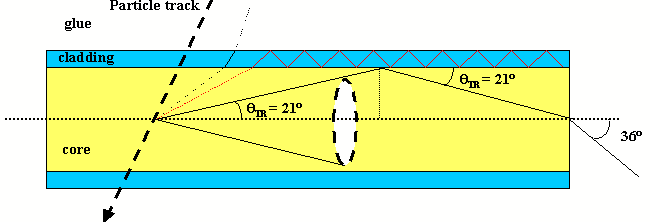![]() A scintillator can be built also as an optical fiber.
In this case the internal nucleus is typically a polistirene base doped with
organic moleculae.
The internal nucleus is called core while the external protection
(typically plexiglass) is called cladding. The cladding has a lower refractive
index respect to the core (tipically 1.5 vs. 1.6)
A scintillator can be built also as an optical fiber.
In this case the internal nucleus is typically a polistirene base doped with
organic moleculae.
The internal nucleus is called core while the external protection
(typically plexiglass) is called cladding. The cladding has a lower refractive
index respect to the core (tipically 1.5 vs. 1.6)
![]() The difference between the two refraction indecies gives origin to a special
quality in the propagation of light in the fiber since it is limited by total
internal reflection in a cone within an angle of 21 degrees (trapping angle)
respect to the fiber axis.
The difference between the two refraction indecies gives origin to a special
quality in the propagation of light in the fiber since it is limited by total
internal reflection in a cone within an angle of 21 degrees (trapping angle)
respect to the fiber axis.
![]() The quantity of the light reaching the fiber end is small (not exceeding 3%)
but the forward propagation decrease the number of reflections on the cladding
guaranteeing a long attenuation length and small time dispersion along the fiber
length.
The quantity of the light reaching the fiber end is small (not exceeding 3%)
but the forward propagation decrease the number of reflections on the cladding
guaranteeing a long attenuation length and small time dispersion along the fiber
length.
![]() The light trapped in the cladding that is more strongly attenuated is essentially
captured by the external glue that has a refractive index comparable to the one of
the fiber core.
The light trapped in the cladding that is more strongly attenuated is essentially
captured by the external glue that has a refractive index comparable to the one of
the fiber core.
